Growing Apples and Pears
in the Sacramento Valley
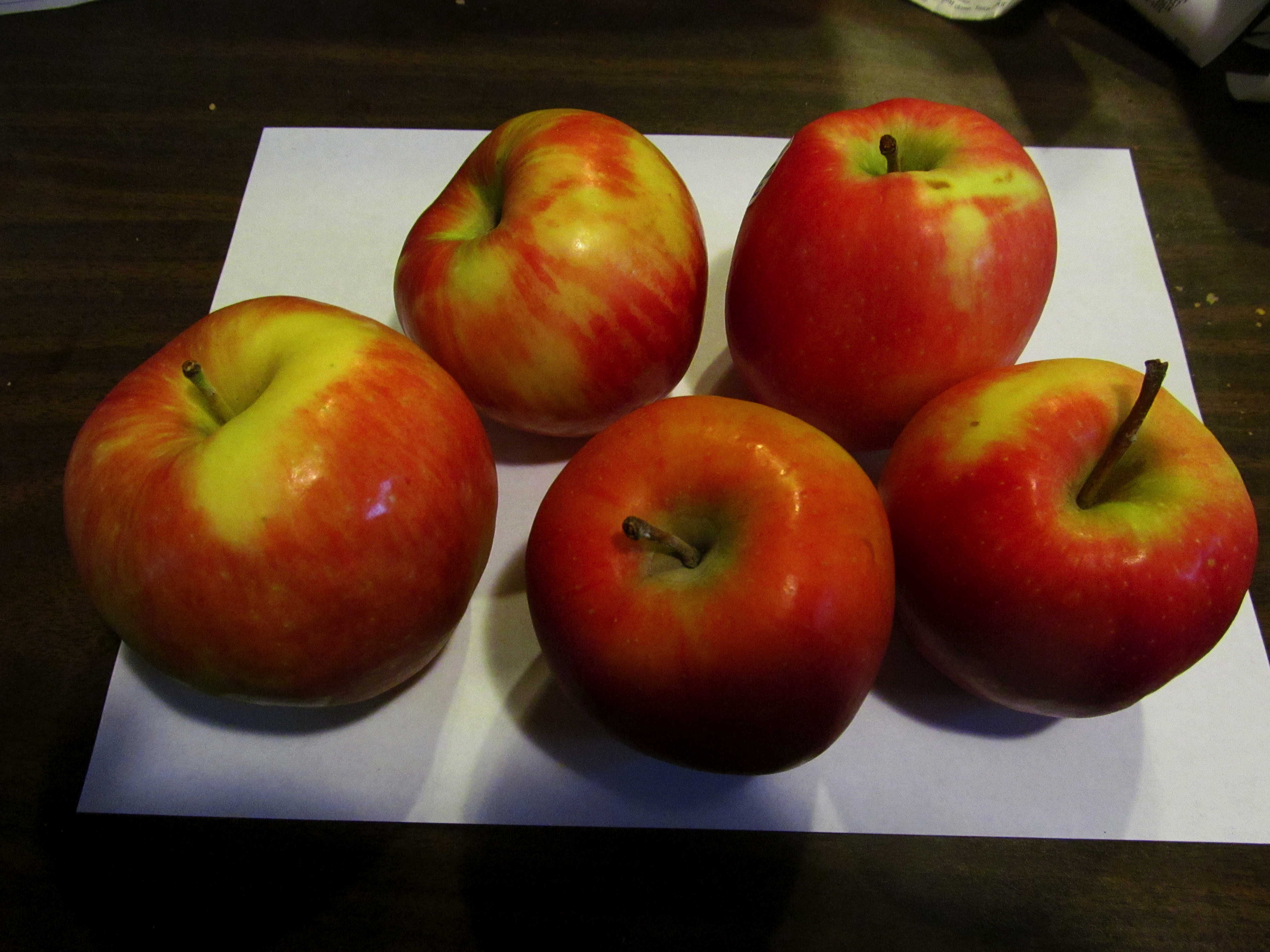
A sampling of 'branded' apples from the grocery store. Left to right: Ambrosia®, Jazz™, Honeycrisp, and two Pink Lady® apples. The first two are not available as garden trees due to marketing restrictions. Honeycrisp and Jazz got high ratings in our informal taste test.
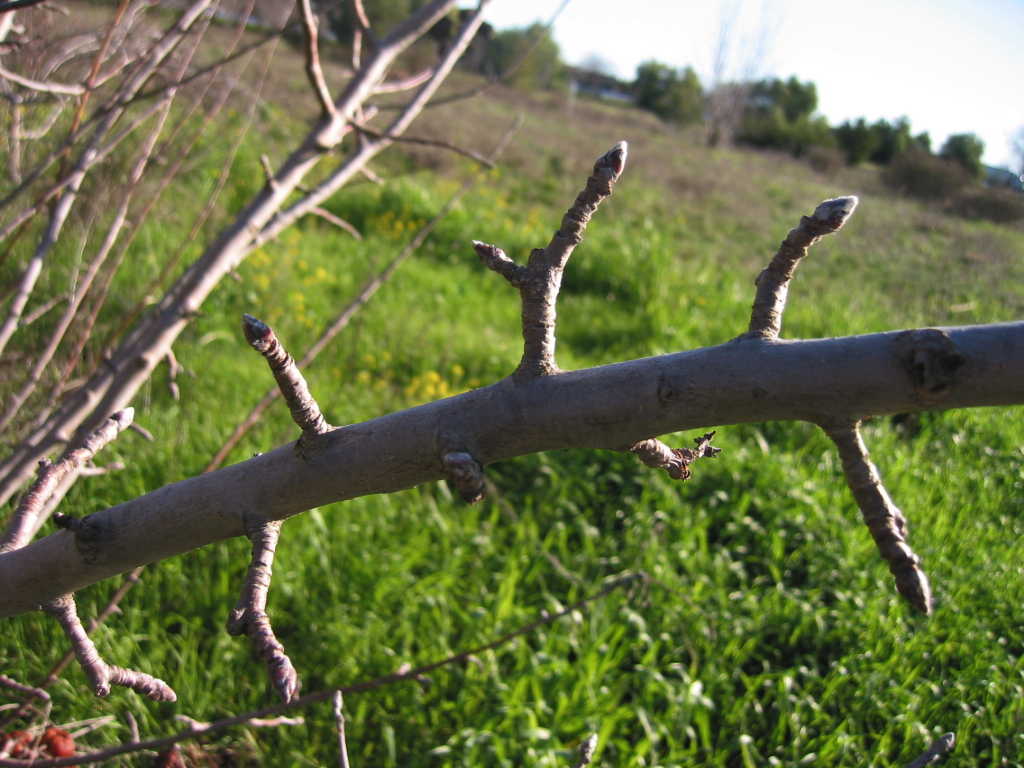 Apples fruit on short spurs that produce fruit for many years. A goal of training and pruning should be to have those spurs at picking height without a ladder.
Apples fruit on short spurs that produce fruit for many years. A goal of training and pruning should be to have those spurs at picking height without a ladder.
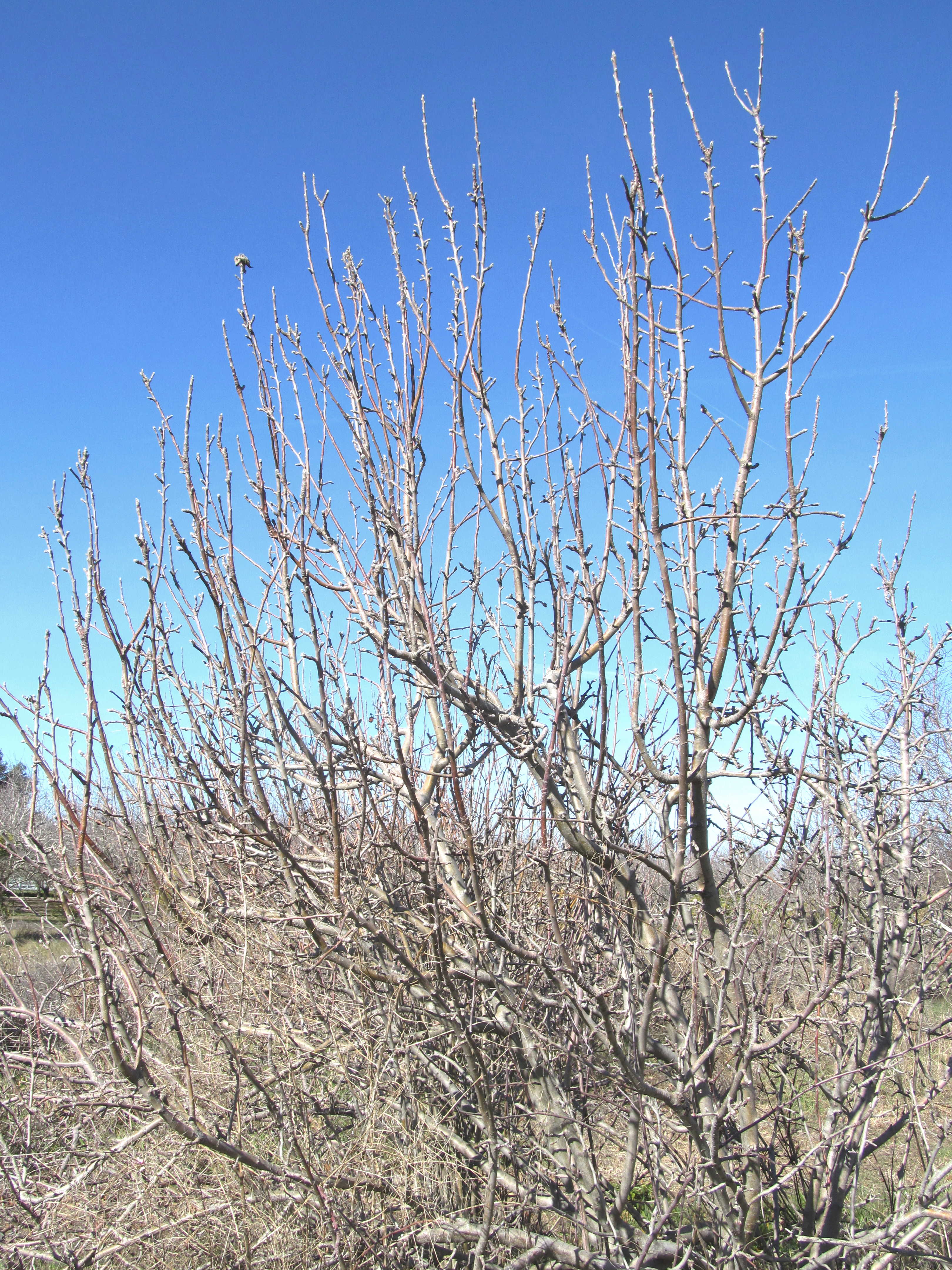 The strongly upright growth habit of apples and pears can lead to trees too tall to spray, prune, and harvest readily. Early training for lower branching, and annual removal of the highest-growing branches, can make your maintenance a lot easier.
The strongly upright growth habit of apples and pears can lead to trees too tall to spray, prune, and harvest readily. Early training for lower branching, and annual removal of the highest-growing branches, can make your maintenance a lot easier.
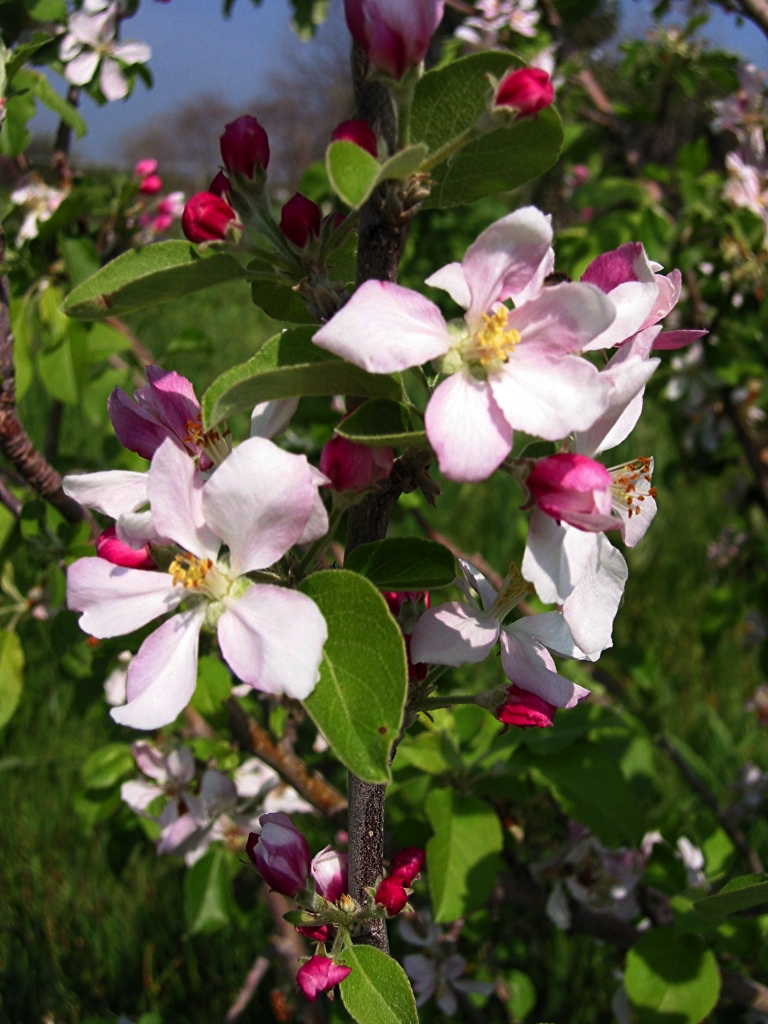 Beautiful apple blossoms in the spring. Most varieties bloom here in April. When you see the flowers, it's time to monitor for codling moth and fireblight. Purchase pheromone traps and check for the adult moths, and watch for sudden dieback of blossoms and new shoots.
Beautiful apple blossoms in the spring. Most varieties bloom here in April. When you see the flowers, it's time to monitor for codling moth and fireblight. Purchase pheromone traps and check for the adult moths, and watch for sudden dieback of blossoms and new shoots.
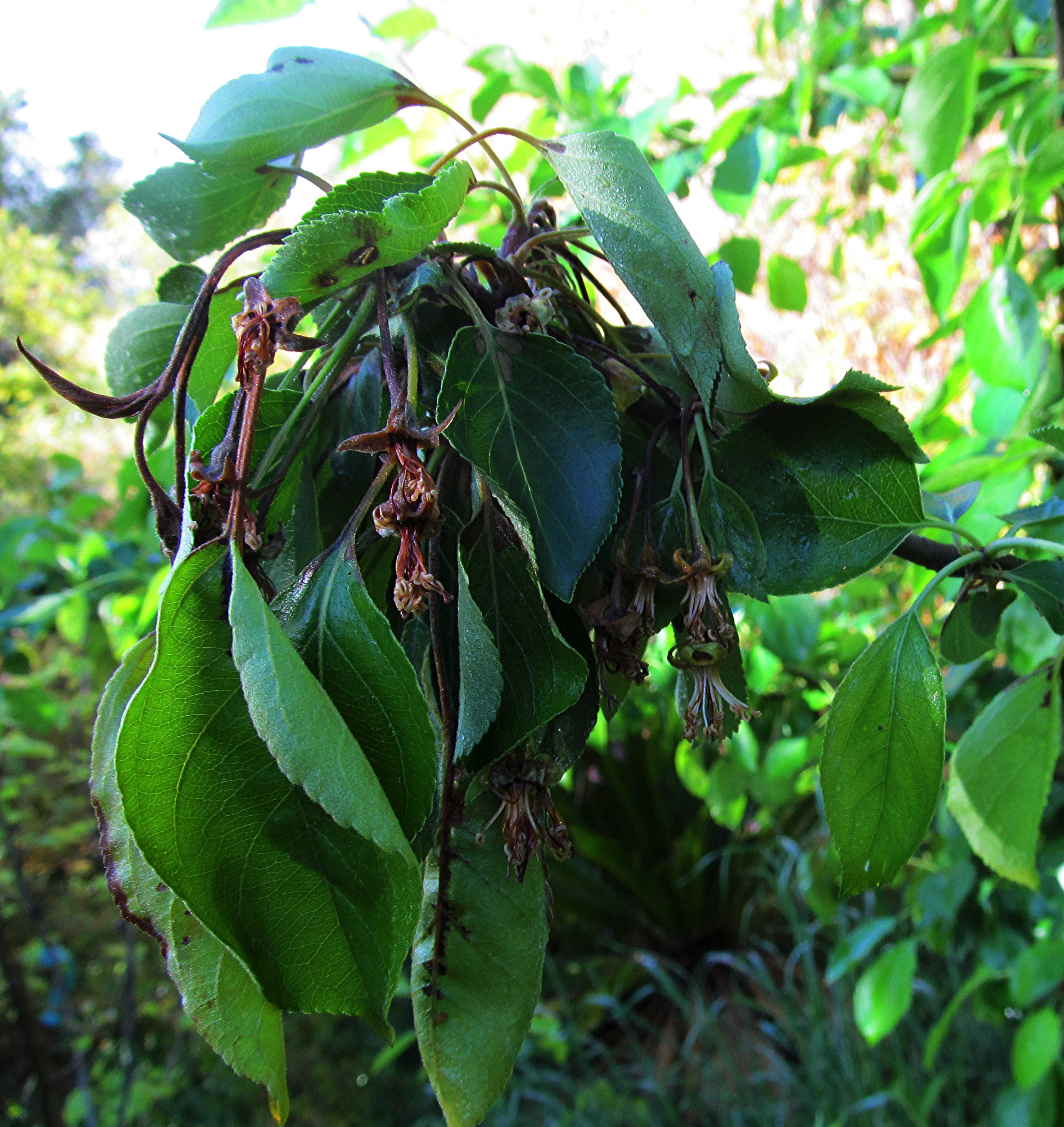 An important part of fireblight management is pruning out infected shoots. This is fireblight a day or so after infection. Within a couple more days, dieback will have progressed several inches down the stem. Carefully cut back infected parts, cutting several inches past the point of infection, and put the prunings in the trash.
An important part of fireblight management is pruning out infected shoots. This is fireblight a day or so after infection. Within a couple more days, dieback will have progressed several inches down the stem. Carefully cut back infected parts, cutting several inches past the point of infection, and put the prunings in the trash.
Growing Apples and Pears
"I just tasted the best apple I've ever had! Can I grow it here?"
As a child I considered apples to be pretty worthless. Growing up in Southern California with a mom who bought cello-pack bags of little tasteless, mealy
Red Delicious apples to pack in our lunches, I never saw why anybody would eat an apple. Red Delicious variety has been selected for color and subjected to
post-harvest storage techniques that have made the name ironic. Red, maybe. Delicious? No. Heck, I couldn't even trade them. In the currency of the
playground, they were literally worthless.
One of the great trends in the produce industry has been the marketing of new varieties of fruit by name, selected and sold for quality in season.
Growers have realized that people will pay a good price for a special variety, grown to perfection and shipped right to market. So taking a cue from the
highly successful citrus marketing programs such as the Cuties® mandarins (at least three different citrus varieties are being marketed under this name),
apple growers are selling trademarked varieties, and maintaining high quality standards.
It's apple season! There's no better time than right now to sample them to see which style you prefer. A recent visit to Nugget Market brought
Ambrosia®, Cameo, Honeycrisp, Jazz™ (the trademark name of SciFresh?), Pink Lady®; these and more are all in stores right now, along with old favorites
like Fuji and Braeburn, and heirloom types such as Arkansas Black. In our blind taste test Honeycrisp and Jazz™ were top rated. Growers at the farmers'
market can tell you which varieties do well for them and let you sample their wares.
So can you grow them in your back yard? Perhaps, with some limitations and some effort. Some varieties are trademarked and patented, and production of
the tree stock is controlled. They actually call these grower groups “clubs,” and you can't join. In other words: in some cases, you can't buy the
trees to grow for yourself. Honeycrisp is available to home gardeners; look for trees during the upcoming bareroot season which begins in January.
Jazz™ apple is trademarked, and the trees are licensed to growers, not available to home growers.
Winter chilling hours and pollination
Apples in general require plenty of winter chilling hours. Many of the popular varieties need 800 hours or more between 32 and 45 degrees in winter in
order to break dormancy and bloom properly. If winters are too warm, they won't flower or fruit. We usually have more than 800 hours here, but not always.
There might be years with limited production with some of these types.
On the other hand, several apple varieties produce reliably in our area, including Anders, Braeburn, Fuji, Granny Smith, Gala, and Gravenstein.
Most apples do not need cross-pollination by another variety to produce adequate crops for home gardeners.
Wormy fruit
The biggest issue with apples is codling moth, which is the worm that bores into the fruit. It's gross, it's common here, and it has several generations
each summer. So if you don't spray to kill it, you will have wormy fruit. Eventually you will have nearly 100% wormy fruit. Lesson #1: always cut into an
apple before you bite into it.
There is an organic spray called spinosad that helps control codling moth. The key is the timing: spray when the moths first appear. Monitor by putting
out pheromone traps at the time the trees bloom. If you spray in April and May, perhaps again in June, you can have a lot of fruit that isn't wormy.
Picking up and discarding the fruit that falls helps to break up the insect's lifecycle.
Efficacy depends on how many neglected apple trees are in your neighborhood. One gardener, determined to get at least some clean fruit, slips No. 4
sandwich bags over a couple of dozen apples as they are developing and staples them shut. Simple, elegant, and it works.
For you to spray effectively, the trees need to be kept short. Apples and pears grow straight up, with vigorous shoots that reach for the sky. Train the
trees from the time of planting for low branching. Head them back in the summer to control the size. Remove strongly upright shoots in winter to keep at
about 8 to 10 feet height.
Apples and pears fruit on short spurs that produce in the same spot on the tree for many seasons. So once you have plenty of spurs at picking height,
you can pretty much remove any branches that grow taller than you want every season.
Resurgent pears?
Pears, cousins of apples in the same tribe of the rose family, are still languishing in the doldrums of the fruit market. A major crop in the Sacramento
Valley in years past, Bartlett pear orchards once lined both sides of Interstate 80 in the Vacaville area. Thousands of acres were grown in the Delta;
Courtland still hosts a pear festival every summer. But pears are not common in backyard orchards.
Why not? Tastes change. Canned pears are not as popular as they used to be. Pear juice is pretty undistinguished, used mostly for blending with other
juices. Over the last couple of decades many acres have been ripped out and replaced with more profitable tree crops. But a fresh pear picked in fall,
carefully ripened on the kitchen counter, is a special treat. And they store easily well into the winter, extending the harvest season.
Select disease resistant varieties.
The most important decision in selecting your pear variety is resistance to bacterial fireblight.
This disease attacks pears, apples, crabapples, and certain other related species through the blossoms or tender new growth. It causes rapid dieback of the
flowers (thus killing the fruit), and into the growing shoots. Tissue death is so rapid that the leaves blacken without falling off as it kills down the
stem for several inches or more.
Fireblight has a very narrow temperature range, infecting for just a few weeks in April and early May. In that short time it can do a lot of damage to
fruiting wood, and can even kill young trees. The best-known and most popular types, such as Bartlett, d'Anjou, and Bosc, are highly susceptible and should
be avoided. Look instead for Fan-Stil, Kieffer, Moonglow, Pineapple, or Warren. Harrow Delight and Seckel have moderate resistance. In the Asian pears (sometimes called Apple pears), Shinko has high resistance.
Sprays are not effective for fireblight. Prune out affected portions, cutting back into healthy wood, and dispose of the infected prunings. The tree will
outgrow the disease as the temperatures increase, and as trees get older they may tolerate it and produce sufficient fruit in spite of infections. But
you'll get much larger crops with less hassle by planting a resistant variety in the first place.
Pears can get codling moth, though the pest seems to prefer apples. Keep your pear trees short so you can spray for that if necessary.
Training and watering
Apple and pear branches are limber when young, making them popular candidates for training flat against fences and walls in the form of espaliers.
You bend the branches horizontally, attach them to the structure, and then continue to prune out upright shoots. This allows them to be grown in smaller
yards and eases picking and maintenance.
Apples and pears can tolerate more watering and poorer drainage than many of our other fruit types, even tolerating lawn watering. They are not as drought
tolerant as other fruit trees. If the trees are drought-stressed in full sun, the fruit and foliage will scorch. A little afternoon shade, and pruning for
greater leaf density, is helpful. For the first couple of summers your trees need water about once a week. Deep soakings every 10 to 14 days can be
sufficient for older trees.
More on fireblight here (pdf)
© 2015 Don Shor, Redwood Barn Nursery, Inc., 1607 Fifth Street, Davis, Ca 95616
www.redwoodbarn.com
Feel free to copy and distribute this article with attribution to this author.
Click here for Don's other Davis Enterprise articles
